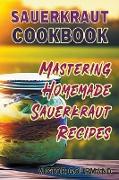- Start
- Sauerkraut Cookbook
Sauerkraut Cookbook
Angebote / Angebote:
As a home chef, I have always been fascinated by the world of fermented foods, and sauerkraut has always been one of my favorites. Its tangy and slightly sour taste, along with its versatility, make it a great addition to a wide range of dishes, from traditional German cuisine to contemporary fusion dishes. This is why I publish "Sauerkraut Cookbook: Mastering Homemade Sauerkraut Recipes."
Making sauerkraut at home is a simple and rewarding process that requires only a few ingredients and tools. All you need is fresh cabbage, salt, and some basic equipment, such as a large mixing bowl, a knife or mandolin, and a fermentation vessel, such as a glass jar or crock. The key to making good sauerkraut is to choose the right type of cabbage and to use the correct amount of salt to create the right environment for the lactic acid bacteria to ferment the cabbage.
Once you have your cabbage and salt, the process of making sauerkraut is quite straightforward. You simply slice or shred the cabbage, mix it with the salt, and then pack it tightly into your fermentation vessel. You can add other ingredients, such as spices, herbs, or vegetables, to create different flavors and textures. Then, you let the cabbage ferment for several days or weeks, depending on your taste preferences and the ambient temperature. During this time, the lactic acid bacteria will convert the natural sugars in the cabbage into lactic acid, which gives sauerkraut its characteristic sour taste and tangy aroma.
The beauty of making sauerkraut at home is that you have complete control over the fermentation process, which allows you to customize the flavor, texture, and acidity of your sauerkraut. You can experiment with different types of cabbage, such as red cabbage, Napa cabbage, or savoy cabbage, to create different colors and textures. You can also add other vegetables, such as carrots, beets, or radishes, to create more complex flavors and textures. Spices and herbs, such as caraway seeds, garlic, dill, or juniper berries, can also add depth and complexity to your sauerkraut.
After your homemade sauerkraut is ready, the possibilities are endless. You can use it as a condiment, as a side dish, or as an ingredient in a wide range of recipes. Classic dishes, such as Reuben sandwiches, sauerkraut and sausage casseroles, or pork and sauerkraut stews, are always crowd-pleasers. However, you can also use sauerkraut in more creative ways, such as in kimchi-inspired tacos, sauerkraut and mushroom risotto, or sauerkraut and apple salad.
One of the great things about sauerkraut is its nutritional value. It is low in calories and fat, and high in fiber, vitamin C, and probiotics, which can improve digestion and boost the immune system. Eating sauerkraut regularly can also help reduce inflammation and prevent certain types of cancer.
Storing and preserving sauerkraut is also easy. Once you have fermented your sauerkraut, you can store it in the refrigerator for several months or even years, depending on the level of acidity and the type of container you use. Canning or pickling sauerkraut is another option, which allows you to preserve the flavor and texture of your sauerkraut for longer periods of time.
Overall, "Sauerkraut Cookbook: Mastering Homemade Sauerkraut Recipes" reveals that making sauerkraut at home is a fun and rewarding experience that allows you to explore new flavors, textures, and health benefits. With a little bit of experimentation and creativity, you can create unique sauerkraut recipes that will delight your taste buds and impress not just you but also your family and guests.
Folgt in ca. 5 Arbeitstagen




